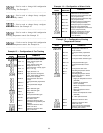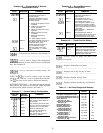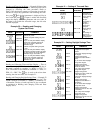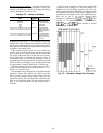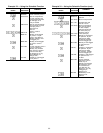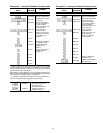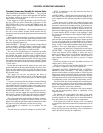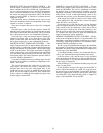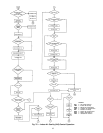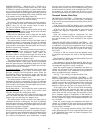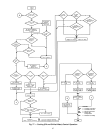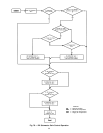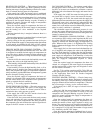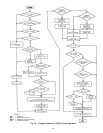
INDOOR-AIR QUALITY (IAQ) — This function main-
tains the correct occupied ventilation rate using CO
2
as an
indicator of occupancy level or controls the levels of volatile
organic compounds (VOCs) or other indoor air pollutants by
modulating the mixed air dampers. Varying quantities of out-
door air are admitted during the Occupied period to main-
tain the ventilation rate at its set point or pollutants at or
below the configured set points of the air-quality (AQ) sen-
sors. See Fig. 76.
CO
2
sensors are available from the factory as options for
field installation. VOC or other types of sensors can be field-
supplied and installed. Sensors used with the IAQ feature
can be configured several different ways:
• One sensor can be installed in either the space or return air
stream to continuously monitor a single gas.
• Two sensors (monitoring the same gas) can be installed in
different locations to provide separate inputs. For ex-
ample, one sensor can be located in an occupied space and
another in the return air duct, or each sensor can be in-
stalled in a different occupied space.
• Two sensors (typically VOC sensors monitoring the same
gas) can be installed inside and outside the occupied space
for comparative measurements. The control is configured
to modify the damper position based on the value of the
sensor in the occupied space, but before admitting outside
air, the control performs a differential check to determine
if the value of the sensor measuring the outside air is higher.
If the outside sensor has a higher value, the damper does
not change position.
Systems with One AQ Sensor — During the unoccupied
period, the minimum damper position maintained by the
IAQ control is 0. During the occupied period, the control
reads the AQ1 sensor input and compares it to the config-
ured set point. The control then calculates the minimum damper
position to maintain the set point. If no other control is at-
tempting to adjust the dampers to a more fully open position
than the IAQ control, the damper is adjusted to the position
determined by the IAQ control. Otherwise, the damper is
positioned by the superseding control routine or at its con-
figured minimum position.
Systems with Two AQ Sensors (Separate Readings) — The
preceding sequence for the AQ1 sensor also applies to the
AQ2 sensor, but the damper position is determined by either
the AQ1 or the AQ2 sensor according to which sensor value
demands the more fully open damper position.
Systems with TwoAQ Sensors (Differential Check) — If dif-
ferential sensing is configured for two VOC sensors, the con-
trol reads the AQ2 (outside air) sensor to determine if its
value is greater or less than that of the AQ1 (indoor air) sen-
sor. If the AQ2 value is greater than the value of the AQ1
sensor, the mixed-air damper position is set to 0. If the AQ2
value is less than the AQ1 value (by at least 1% of the con-
figured minimum sensor value), the control uses the AQ1
value to modulate the dampers and maintain the AQ set point.
IAQ System Protection — To protect the system against coil
freeze-up in cold climates or high heat and humidity in warm
climates, the system provides several user-selectable fea-
tures to override or modify the IAQ functions.An adjustable
maximum position for the mixed-air damper is provided for
each AQ sensor, and a selection is available to maintain the
minimum mixed-air temperature at approximately 45 F. Space
temperature and humidity protection can temporarily sus-
pend IAQ functions until the temperature and humidity con-
ditions return to the desired set points. On VAV systems dur-
ing cooling, the IAQ function can be limited to maintain the
required supply-air temperature.
94



